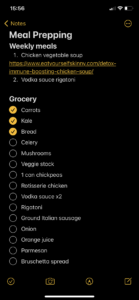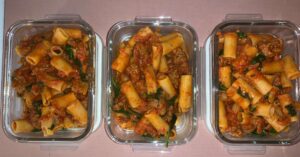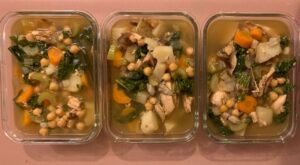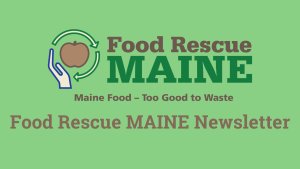
Try Meal Prepping To Stop Wasting Food – Save Money And Time, Too!
Since meal prepping is easily my favorite form of food waste prevention, I wanted to bring you inside my own kitchen to demonstrate how it’s done! But what is meal prepping and why is it so effective? Meal prepping is simply cooking your favorite weekly meals but with a plan – for shopping, cooking, and eating. You plan your shopping list with the purpose of cooking specific meals. You cook those meals with a plan for how many people to feed, how much to eat, and for how many days. Following your plan will prevent you from having a pile of food to throw out at the end of the week. After analyzing my own process, I came up with seven simple steps to make meal prepping a breeze.
Step 1: Be Realistic About Your Lifestyle
The key to meal prepping is to figure out how much food you need. It is important to have a realistic view of your lifestyle. Start off by asking yourself the following questions:
-
- How many people are in my household?
- When do I go to the grocery store?
- How much should I eat at each meal?
- When do I eat out?
- How busy is my typical week?
Your answers to all of these questions will affect your meal prepping plan. Personally, I live on my own, and as a college student, it is not realistic for me to go to the store more than once a week. That being said, every Sunday, I go to the grocery store and buy food for two big, 3-4 serving meals using recommended dietary serving sizes. Then I do all of the prep work and cooking that afternoon. I have found that six large servings(sometimes I split one serving up into two for lunch) will get me through a full week, and when I make more than that for just myself, my tendency to eat out gets in the way and I end up having to freeze a meal or two.
If you are having any problems conceptualizing how much food you will need for your household, click here to try NRDC’s Save the Food digital meal prepping planner. This software will allow you to enter the number of people and days that you are cooking for and develop a plan based on this information.
Step 2: Get Prepared
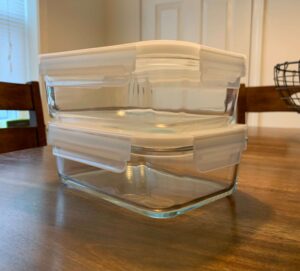
Make sure that you have everything you need to get started. In addition to food, this just means plenty of containers. I use six single-serving glass storage containers (no BPA’s for me!). Using the same-sized containers simply makes them easy to stack and fit in the fridge nicely. I would also recommend choosing a brand that is microwave and dishwasher safe, as this will make reheating your food and cleaning up throughout the week easier.
When you are choosing containers, use brands that are freezer safe to allow you to freeze some meals, if needed. Click here to read the New York Times’, “Tools and Tips for Freezing Food so Nothing Goes to Waste.”
Step 3: “Shop” Your Fridge and Pantry First
The next step to great meal prepping (and a most crucial step in preventing food waste) is to “shop” the food that you already have in your refrigerator and pantry and incorporate that food into your meals. If you use the food already available to you, you can avoid wasting food and save money buying unnecessary duplicates. After “shopping” my own kitchen, I knew that I had potatoes, onions, and spinach that I needed to get rid of before they spoiled– but I still needed some more inspiration to figure out what I wanted to cook.
If you are having trouble coming up with meals based on the ingredients that you have, click here to visit MyFridge and simply check off your ingredients to find recipe ideas.
Step 4: Select Your Recipes – Get Inspired
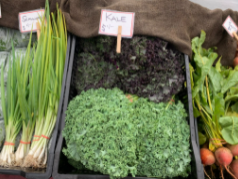
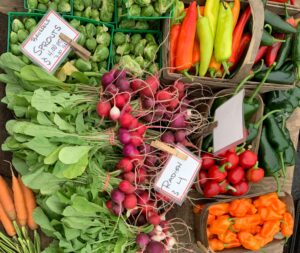
This is my favorite part of meal prepping (in addition to eating, of course) — figuring out what recipes to make! This week I have a visitor that is not quite as excited about my plant-based meals, so I needed some new ideas.
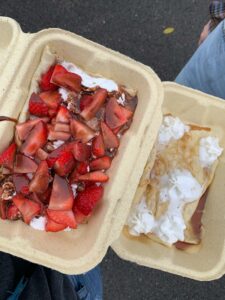
I got up early on Saturday morning to hit my local farmers’ market and see if I could get my hands on some fresh, seasonal produce to inspire my recipes for this week. I ended up coming away with a few things: a beautiful bunch of kale, garden-grown carrots, freshly baked seeded rye, apple cider from a local orchard, and some crepes– for some much needed brain fuel. With all of these lovely fall ingredients, I had the perfect items to incorporate into one of my favorite soups – a chicken and vegetable soup recipe that has been my favorite for years now. Soups are perfect for meal prepping because they are an amazing way to use up the leftover items in your kitchen. You can almost never go wrong by adding, substituting, or taking out a few ingredients of your favorite soup. For my second meal, I decided on a simple vodka sauce rigatoni recipe- for no other reason than it was requested- and I needed to get rid of some spinach.
Step 5: Smart Grocery Shopping
After you have taken an inventory of your fridge and pantry and picked your meals, it is time to make your grocery list and go shopping. As you can see, I had little items to buy this week, because I already had many of the ingredients. Meal prepping makes you take stock of your resources and use them to their full potential. When you go into the grocery store, try to stick to only the items that you put on your list. Coupons and bulk deals can be very tempting, but I find that I usually end up spending extra money on these discounted foods, and then they go to waste anyway. This is why being realistic about your lifestyle is so important.
Step 6: Cook and Package
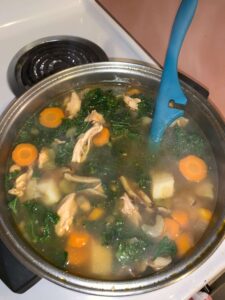
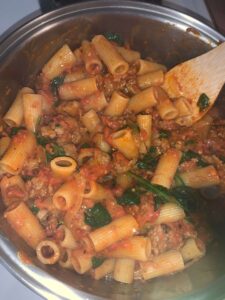 I choose to do all of my shopping and cooking on Sunday, because it is the beginning of a new week, and it works best for my busy school schedule. Make sure you pick a day that you have a few hours to spare. Then, simply cook the food that you planned. After you have finished cooking your meals, let your food cool. Then serve equal portions into your containers and pop them into the fridge or freezer to store. Once you are comfortable with basic meal prepping, don’t be afraid to try new recipes and to creatively use up the food in your kitchen.
I choose to do all of my shopping and cooking on Sunday, because it is the beginning of a new week, and it works best for my busy school schedule. Make sure you pick a day that you have a few hours to spare. Then, simply cook the food that you planned. After you have finished cooking your meals, let your food cool. Then serve equal portions into your containers and pop them into the fridge or freezer to store. Once you are comfortable with basic meal prepping, don’t be afraid to try new recipes and to creatively use up the food in your kitchen.
Step 7: Eat and Enjoy!
The easiest and final step of the process is eating your meals! You have planned out your entire week of meals with a plan. You saved money by using what you had. The best part of meal prepping is that now you are free from cooking for the rest of the week. You just have to take out a meal and pop it in the microwave or heat it on the stove. There will be no more worrying about cooking after work, or spending money on food when there is “nothing in the house”. You have planned with purpose, and now you have some time to relax.
And always remember- Maine food is too good to waste.
-Hannah M., Mitchell Center Student Intern
I’m a novel-reading, chocolate connoisseur who enjoys *short but sweet* hikes, and trying new plant-based recipes.
Citations:
- EPA Smart Prep: Prep Now, Eat Later infographic
- EPA: Reducing Wasted Food at Home- Tips for Planning, Storage, Prep, and Thriftiness
- Meal Prep Mate: Don’t know how much food you need? Save the Food’s digital tool will help you build a meal prep plan for your household.
- Meal Prep Mate: Follow this pre-planned week of meals(includes recipes!) by Save the Food.
- The New York Times’, “Tools and Tips for Freezing Food so Nothing Goes to Waste.”
- Want to Find Recipes to Cook with the Ingredients in Your Kitchen: Try MyFridge

